SUBFAMILY MYRMICINAE - Genus Monomorium Mayr
| The Ants
of Egypt SUBFAMILY MYRMICINAE - Genus Monomorium Mayr |
In Tribe SOLENOPSIDINI.
Diagnostic Features - Antennae 11- or 12-segmented, with a 3-segmented club. Median portion of clypeus with two distinct longitudinal carinae; clypeus may also be concave between the carinae on the anterior margin, the carinae then project as a pair of blunt teeth. Eyes present. Promesonotal suture absent, metanotal groove impressed. Propodeum unarmed. Petiole pedunculate, node high and rounded. Postpetiole node less voluminous than petiole node in profile and narrowly attached to the gaster.
Mayr (1861: 71) reiterated his earlier (1855) genus description,
this is at ![]() .
.
Emery (1915i: 190) listed what then were regarded as valid
subgenera - and defined the subgenus Parholcomyrmex, type
species Monomorium gracillima (as Myrmica gracillima,
now a junior synonym of Monomorium destructor) - see ![]() . The main characteristics Emery listed
were - slightly dimorphic workers; funiculus with a three-segmented
club (Monomorium santschii with four segmented-club, type
location Tunisia), the first two segments equi-sized.Emery (1922e)
later synonymised Mitara with the older name Lampromyrmex,
itself now regarded as a synonym of Monomorium.
. The main characteristics Emery listed
were - slightly dimorphic workers; funiculus with a three-segmented
club (Monomorium santschii with four segmented-club, type
location Tunisia), the first two segments equi-sized.Emery (1922e)
later synonymised Mitara with the older name Lampromyrmex,
itself now regarded as a synonym of Monomorium.
The subgenus Holcomyrmex was defined by Mayr (1879: 671) , type species Monomorium scabriceps (as Holcomyrmex scabriceps, type location India) - see Emery's key (1915i: 190) - Card 2. The main characteristics Emery listed were - antennal club much shorter than rest of funiculus, often indistinct; workers pronouncedly dimorphic.
The Genus Syllophopsis was defined by Santschi (1915c: 259)
and further tackled by Santschi (1921c: 119) - see ![]() and
and ![]() . Ettershank (1966) kept Syllophopsis
separate from Monomorium but noted that he had not examined any
specimens of Syllophopsis. Bolton (1987), however, synonymised Syllophopsis
with Monomorium and he chose to set aside the concept of
subgenera, instead using a format of species-groups, with a subordinate
level of species-complexes. As a point of correction, Bolton (1987:
296) commented upon the subgenus Parholcomyrmex, as defined by
Emery (1915i); writing that the name was - "also misspelled as Paraholcomyrmex
later in the same publication". As the original text shows, it is
obvious that Emery intended the name to be Paraholcomyrmex,
literally (para-) similar to Holcomyrmex, as the name is
printed in bold in the key, with the comment (translated) = male as Holcomyrmex.
. Ettershank (1966) kept Syllophopsis
separate from Monomorium but noted that he had not examined any
specimens of Syllophopsis. Bolton (1987), however, synonymised Syllophopsis
with Monomorium and he chose to set aside the concept of
subgenera, instead using a format of species-groups, with a subordinate
level of species-complexes. As a point of correction, Bolton (1987:
296) commented upon the subgenus Parholcomyrmex, as defined by
Emery (1915i); writing that the name was - "also misspelled as Paraholcomyrmex
later in the same publication". As the original text shows, it is
obvious that Emery intended the name to be Paraholcomyrmex,
literally (para-) similar to Holcomyrmex, as the name is
printed in bold in the key, with the comment (translated) = male as Holcomyrmex.
The full original text of Bolton's revisionary study can be found at
-
Bolton,
B. 1987. A review of the Solenopsis genus-group and
revision of Afrotropical Monomorium Mayr (Hymenoptera:
Formicidae). Bull.
Brit. Mus. (Nat. Hist.) Entomol. 54:
263-452. download entire file (16.6M) ![]()
André (1883a: 330) gave a key to the species then known from Europe
and North Africa this is at ![]() . Monomorium
gracillimum F Smith = Monomorium destructor (Bolton, 1987:
324). Santschi (1936a) attempted to sort out members of the subgenus Xeromyrmex
Emery (1915), these essentially are members of the "salomonis-group"
defined by Bolton (1987: 329). Unfortunately, although Bolton stated he
had examined 15 extralimital species, in addition to the Afrotropical
species dealt with in the paper, he has not gone on to publish modern
descriptions of the extralimital species. Menozzi's (1933b) key to Monomorium
from Palestine is at
. Monomorium
gracillimum F Smith = Monomorium destructor (Bolton, 1987:
324). Santschi (1936a) attempted to sort out members of the subgenus Xeromyrmex
Emery (1915), these essentially are members of the "salomonis-group"
defined by Bolton (1987: 329). Unfortunately, although Bolton stated he
had examined 15 extralimital species, in addition to the Afrotropical
species dealt with in the paper, he has not gone on to publish modern
descriptions of the extralimital species. Menozzi's (1933b) key to Monomorium
from Palestine is at ![]() .
.
Thus, from Bolton (1987) the known Egyptian species fall into the species-groups as follows, except following the genus redefinitions in Ward et al. (2014: 10) the Trichomyrmex from Egypt are - abyssinicus, plus "destructor-group" members, destructor and mayri.
| fossulatum-group | former Syllophopsis - with much reduced eyes, usually down to a single ommatidium, very narrow posteromedian portion of the clypeus, and a large strongly differentiated antennal club | dentatum |
| scabriceps-group | former Holcomyrmex - mandibles unsculptured; propodeal spiracle a short, near vertical, slit; polymorphic | Trichomyrmex abyssinicus |
| destructor-group | Propodeum rounded; mandibles sculptured; eyes small but distinct (0.13-0.20 X HW); propodeum dorsum transversely striate to costulate, even if only faintly | Trichomyrmex destructor and Trichomyrmex mayri |
| monomorium-group | Mandibles unsculptured; antennae 11-segmented (for Egypt/North Africa); propodeum dorsum smooth or if sculptured not with transverse striations; standing hairs at pronotal humeri | atomum, carbonarium (note specimen photographed by Sharat is clavicorne), clavicorne, and mictilis; given for comparison exiguum and monomorium |
| salomonis-group | Usually with distinct cephalic sculpture; eye moderate, oval or circular not reniform; scapes usually ca SI > 90; metanotal groove no more than weakly impressed | - |
| areniphilum-complex |  Cephalic sculpture overlain by very fine dense
scratch-like longitudinal striation, large eyes, characteristic altrunk
outline; first gastral tergite with no more than a single pair of erect
hairs forward of apical row Cephalic sculpture overlain by very fine dense
scratch-like longitudinal striation, large eyes, characteristic altrunk
outline; first gastral tergite with no more than a single pair of erect
hairs forward of apical row |
areniphilum and related forms in North Africa; we include abeillei, lepineyi and pullulum, both new status species |
| australe-complex | Small to minute species, with fine sculpturation giving silky appearance [Curiously there are no illustrations in the literature - despite the proliferation of species by Bolton, 1987] | carbo |
| bicolor-complex | Orange-yellow to red, gaster dark brown to black often with steely or bluish reflections, quite small eyes; sharply defined dense sculpture, with individual punctures small but very sharply defined; always with erect hairs present on first gastral tergite in front of apical row; erect hairs absent on alitrunk dorsum | bicolor, jizane & nitidiventre [Bolton states this sibling-species of bicolor replaces it in part around the eastern end of the Mediterranean] |
| pharaonis-complex | Cephalic dorsum and alitrunk everywhere blanketed by fine and very dense reticulate-punctulate sculpture; relatively small eyes (0.18-.0.21 X HW) set slightly in front of the midlength of the head; SI 105; metanotal groove distinctly impressed; pair of erect hairs on pronotal humeri and on mesonotum; first gastral tergite with standing hairs distributed evenly over the sclerite | pharaonis |
| subopacum-complex | With reduced but clearly visible cephalic sculpture and stronger sculpture on alitrunk; first gastral tergite with one or more pairs of erect hairs forward of apical row | subopacum; presumably also salomonis and venustum |
| others | Not separated in Bolton, 1987 - scape clearly surpassing the occiput, with relatively long slender funiculi; propodeal spiracle distinctly ovoid and anteriorly raised so that opening facing slightly rearward; propodeum with distinctive flat wedge-shaped dorsum | niloticum |
| ungrouped ? chobauti-group (our designation) |
not mentioned in Bolton, 1987; possibly in
former subgenus Equestrimessor Santschi (1919a), as
transporting grass seeds in a psammophore on the underside of the head; Ward et al. (2015) placed these in Trichomyrmex |
bodenheimeri
and, for comparison, barbatulum and chobauti |
| - | not mentioned in Bolton, 1987 | phoenicium |
Provisional key to workers (* = not presently known from Egypt)
| 1 |  Antennae 11-segmented Antennae 11-segmented |
2 |
| -- |  Antennae 12-segmented Antennae 12-segmented |
5 |
| 2 |  TL 1.5-1.7 mm; yellow, head and gaster more brown; cuticle
of head translucent; lateral mesonotum and propodeum very finely
rugoreticulate; erect hairs moderately long but relatively sparse;
pronotum dorsum anteriorly with two pairs of long erect hairs. TL 1.5-1.7 mm; yellow, head and gaster more brown; cuticle
of head translucent; lateral mesonotum and propodeum very finely
rugoreticulate; erect hairs moderately long but relatively sparse;
pronotum dorsum anteriorly with two pairs of long erect hairs. |
Pan-African (not definite from Egypt) - exiguum |
| -- | TL < 1.5 mm; wholly smooth, very shiny; no sculpturation on lateral mesonotum and propodeum | 3 |
| 3 |  TL 1.2-1.3 mm; apical
segment of club as long as previous
8 segments together, those segments much wider than long; head an
elongated rectangle; metanotal groove deep so that alitrunk forms two
convexities; petiole with short peduncle, subconical, postpetiole more
rounded, both segments small; few erect hairs; wholly smooth and shiny;
wholly yellow with slight reddish tint, legs paler TL 1.2-1.3 mm; apical
segment of club as long as previous
8 segments together, those segments much wider than long; head an
elongated rectangle; metanotal groove deep so that alitrunk forms two
convexities; petiole with short peduncle, subconical, postpetiole more
rounded, both segments small; few erect hairs; wholly smooth and shiny;
wholly yellow with slight reddish tint, legs paler |
Middle East,
inc Egypt, to Indian subcontinent - atomum |
| -- | Metanotal groove shallow with alitrunk profile not separated into two convexities | 4 |
| 4 |  TL 1.4 mm; second segment of
funiculus slightly longer
than wide, large 3-segmented club, with apical segment twice as long as
previous two together; pilosity very sparse on alitrunk, abundant on
appendages and fairly so on gaster, whitish; no pubescence; smooth,
very shiny; clear testaceous yellow, gaster apex sometimes slightly
darkened TL 1.4 mm; second segment of
funiculus slightly longer
than wide, large 3-segmented club, with apical segment twice as long as
previous two together; pilosity very sparse on alitrunk, abundant on
appendages and fairly so on gaster, whitish; no pubescence; smooth,
very shiny; clear testaceous yellow, gaster apex sometimes slightly
darkened |
Israel, Egypt
& Tunisia - clavicorne |
| -- |  TL
1.2-1.3 mm; yellow, apex of gaster darker; pronotum dorsum anteriorly
with a single pair of long erect hairs; head with a noticeably
depressed profile (at least upper if not lower surface) TL
1.2-1.3 mm; yellow, apex of gaster darker; pronotum dorsum anteriorly
with a single pair of long erect hairs; head with a noticeably
depressed profile (at least upper if not lower surface) |
eastern & southern Africa, Egypt - mictilis |
| - | Antennae 12-segmented | . |
| 5 |  Propodeal spiracle vertically slit-shaped or elliptical;
anterior clypeal margin with a pair of prominent teeth overhanging the
mandibles, heavy mandibles, polymorphic (TL 2.6-6.7), granivorous
savannah species Propodeal spiracle vertically slit-shaped or elliptical;
anterior clypeal margin with a pair of prominent teeth overhanging the
mandibles, heavy mandibles, polymorphic (TL 2.6-6.7), granivorous
savannah species |
Pan-Sahel
species Trichomyrmex abyssinicus |
| -- | Propodeal spiracle circular or nearly so; no prominent teeth on anterior clypeal margin | 6 |
| 6 | Head in profile flat or shallowly convex and with long hairs on clypeal margin and underside of head | 7 |
| -- | Head in profile at least slightly convex ventrally, without numerous hairs on the underside | 8 |
| 7 | 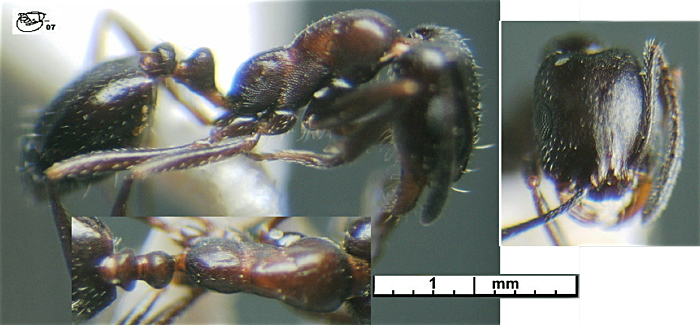 Eye
flat and larger, elongated oval; scape not reaching occiput, underside
of head slightly convex; psammophore relatively weak; in dorsal view
postpetiole a weak small oval; first gastral tergite without erect
hairs except on posterior margin Eye
flat and larger, elongated oval; scape not reaching occiput, underside
of head slightly convex; psammophore relatively weak; in dorsal view
postpetiole a weak small oval; first gastral tergite without erect
hairs except on posterior margin |
Egypt
- Trichomyrmex bodenheimeri |
| -- | 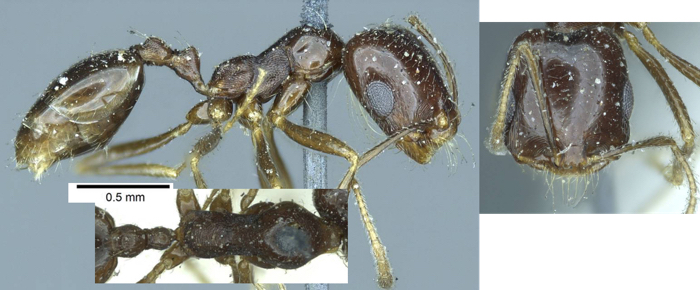 TL 2.5-3.0 mm; underside of head flat; head unsculptured
or finely granulous, except antennal fossae and genae which are
striated, with with striations on the clypeus; alitrunk subopaque,
except disc of pronotum which is smooth and shiny; petiole nodes near
shiny; gaster smooth and very shiny; pilosity and pubescence sparse,
very long hairs on clypeus and underside of head; pitch black,
funiculus and legs brownish, apex of mandibles and tarsi testaceous TL 2.5-3.0 mm; underside of head flat; head unsculptured
or finely granulous, except antennal fossae and genae which are
striated, with with striations on the clypeus; alitrunk subopaque,
except disc of pronotum which is smooth and shiny; petiole nodes near
shiny; gaster smooth and very shiny; pilosity and pubescence sparse,
very long hairs on clypeus and underside of head; pitch black,
funiculus and legs brownish, apex of mandibles and tarsi testaceous |
* Turkestan - probably also in Trichomyrmex - barbatulum |
| -- |  Eye
smaller; scape not reaching occiput, underside of head slightly
concave; psammophore well developed; in dorsal view postpetiole a
square; first gastral tergite without numerous semi-decimbent hairs Eye
smaller; scape not reaching occiput, underside of head slightly
concave; psammophore well developed; in dorsal view postpetiole a
square; first gastral tergite without numerous semi-decimbent hairs |
Algeria
- Trichomyrmex chobauti |
| - | Head without psammophore hairs | . |
| 8 | 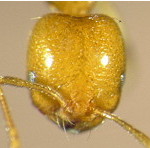 Head
shiny, smooth or lightly striated anteriorly and on the sides, sparse
piligerous punctuation Head
shiny, smooth or lightly striated anteriorly and on the sides, sparse
piligerous punctuation |
9 |
| -- | 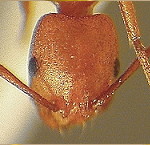 Head,
other than part of clypeus, entirely and variably finely granulose,
variably slightly shiny to matt Head,
other than part of clypeus, entirely and variably finely granulose,
variably slightly shiny to matt |
14 |
| - | Head almost entirely shiny | . |
| 9 | 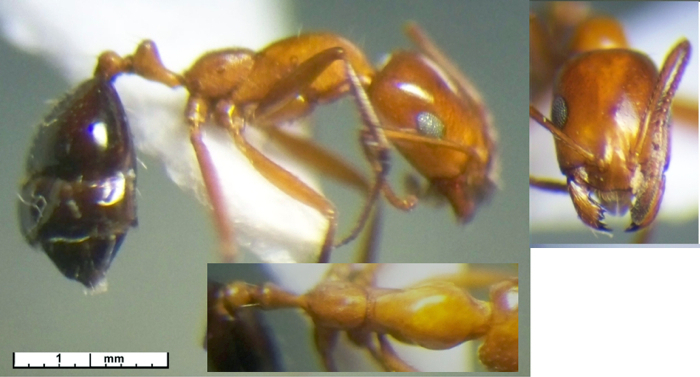 TL ca 3.8 mm; eyes
large occupying about one-third of side of head and distinctly sunken
into sides of head; scapes surpass the occiput; distinctly bicoloured, all except
gaster yellowish-brown, gaster brownish-black, darkest apically TL ca 3.8 mm; eyes
large occupying about one-third of side of head and distinctly sunken
into sides of head; scapes surpass the occiput; distinctly bicoloured, all except
gaster yellowish-brown, gaster brownish-black, darkest apically |
niloticum |
| -- | Eyes small to minute, occupying 0.25-0.20 of sides of head or minute of a single ommatidium | 10 |
| 10 |  Eyes
of a single ommatidium; propodeum with distinct denticles Eyes
of a single ommatidium; propodeum with distinct denticles |
Egypt - dentatum
n sp Sharaf |
| -- |  Eyes small, occupying 0.25-0.20 of sides of head; whole of
body smooth and almost so, other than several transverse rugae on the
propodeum Eyes small, occupying 0.25-0.20 of sides of head; whole of
body smooth and almost so, other than several transverse rugae on the
propodeum |
11 |
| 11 | Pedicel slender and elongated | 12 |
| -- | Pedicel slightly elongated, petiole with a short peduncle, postpetiole wider than long | 13 |
| 12 | 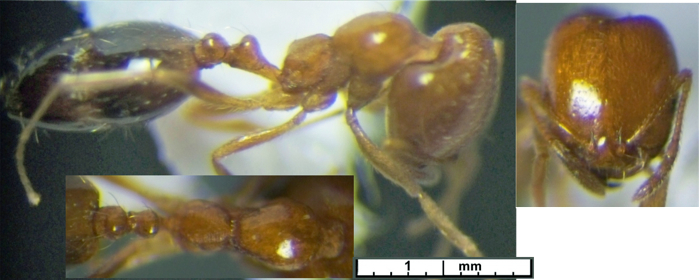 TL
2.2-3.0 mm; postpetiole longer than wide; pilosity sparse, pubescence
almost nil; colour variable testaceous yellow to red-brown, with gaster
brown-black, with dark varieties appendages tend to be brighter TL
2.2-3.0 mm; postpetiole longer than wide; pilosity sparse, pubescence
almost nil; colour variable testaceous yellow to red-brown, with gaster
brown-black, with dark varieties appendages tend to be brighter |
North Africa
through Middle East to India and tramp [gracillimum F Smith] Trichomyrmex destructor |
| -- | 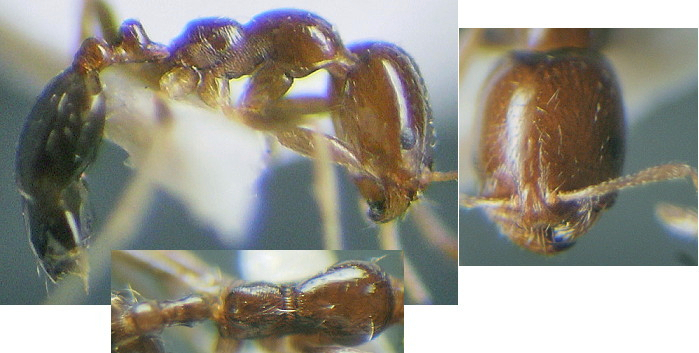 Generally dark brown, with more pronounced transverse
sculpturation on the propodeum; erect hairs relatively abundant,
especially on the alitrunk dorsum Generally dark brown, with more pronounced transverse
sculpturation on the propodeum; erect hairs relatively abundant,
especially on the alitrunk dorsum |
Trichomyrmex mayri |
| 13 |  TL
1.5-2.0 mm; pedicel of petiole relatively short; pilosity very sparse,
pubescence almost nil; black or brown black, appendages reddish yellow TL
1.5-2.0 mm; pedicel of petiole relatively short; pilosity very sparse,
pubescence almost nil; black or brown black, appendages reddish yellow |
* southern
Europe, North Africa, Syria, Madeira & North America [minutum Mayr] monomorium |
| -- |  TL
a little more than 2 mm; clypeus with short deep longitudinal notch
limited laterally by carinae which terminate in a raised tooth; even
darker to wholly black TL
a little more than 2 mm; clypeus with short deep longitudinal notch
limited laterally by carinae which terminate in a raised tooth; even
darker to wholly black |
North Africa, Yemen (Aden),
Madeira, America carbonarium |
| . | Head almost entirely granulose-reticulate, no more than slightly shiny if not matt | . |
| 14 |  TL
1.75-2.3 mm; funiculus with first segment as long as next three
combined; pilosity very sparse, pubescence almost nil; body overall
finely granulose-reticulate, matt, except median area of clypeus and
gaster which are smooth and shiny; entirely yellow sometimes slightly
reddish, with gaster variably blackish apically TL
1.75-2.3 mm; funiculus with first segment as long as next three
combined; pilosity very sparse, pubescence almost nil; body overall
finely granulose-reticulate, matt, except median area of clypeus and
gaster which are smooth and shiny; entirely yellow sometimes slightly
reddish, with gaster variably blackish apically |
Pan-global
tramp pharaonis |
| -- |  Funiculus with first segment about the same length as next
two segments combined Funiculus with first segment about the same length as next
two segments combined |
15 |
| 15 |  Head
elongated, CI ca 75 or less, with occiput noticeably impressed (best
seen from above head rather than full-face view) Head
elongated, CI ca 75 or less, with occiput noticeably impressed (best
seen from above head rather than full-face view) |
16 |
| -- | 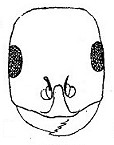 Head only slightly elongated, CI 80 plus, oval with sides
rounded; occiput not or only slightly impressed and slightly widest
anteriorly Head only slightly elongated, CI 80 plus, oval with sides
rounded; occiput not or only slightly impressed and slightly widest
anteriorly |
18 |
| 16 | 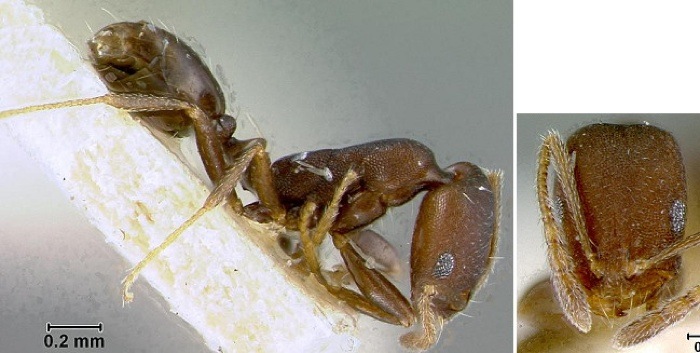 TL 1.6-1.7 mm (Forel) [Bolton
(1987) has TL 2.3-2.4 mm]; scape reaching the occiput; head
pronouncedly rectangular, CI 71-72; metanotal groove very shallow; no
propodeal longitudinal groove; head and alitrunk brown or darker,
gaster black TL 1.6-1.7 mm (Forel) [Bolton
(1987) has TL 2.3-2.4 mm]; scape reaching the occiput; head
pronouncedly rectangular, CI 71-72; metanotal groove very shallow; no
propodeal longitudinal groove; head and alitrunk brown or darker,
gaster black |
Eritrea and
? Egypt carbo |
| -- | Bicoloured with head and alitrunk distinctly lighter, red or reddish-brown, than dark brown to black gaster | 17 |
| 17 | 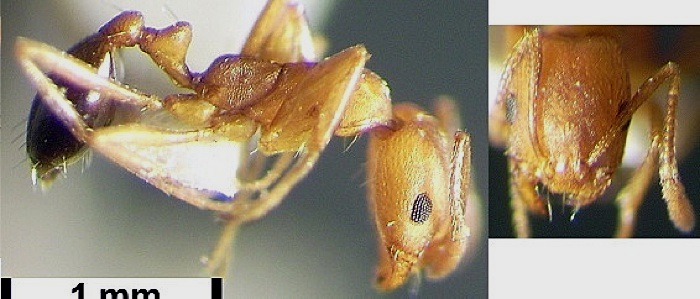 TL
2.5-3.5 mm; head with sides almost straight and parallel; little
pilosity and fine sparse pubescence; propodeal spiracle minute and
circular; petiole in dorsal view quite narrow; head, alitrunk and
petiole densely but quite finely granular; gaster superficially
shagreened, shinier ventrally; entirely light red with gaster
black-brown, often with basal reddish area TL
2.5-3.5 mm; head with sides almost straight and parallel; little
pilosity and fine sparse pubescence; propodeal spiracle minute and
circular; petiole in dorsal view quite narrow; head, alitrunk and
petiole densely but quite finely granular; gaster superficially
shagreened, shinier ventrally; entirely light red with gaster
black-brown, often with basal reddish area |
Egypt and
sub-saharan Africa, north of the Equator bicolor |
| -- | 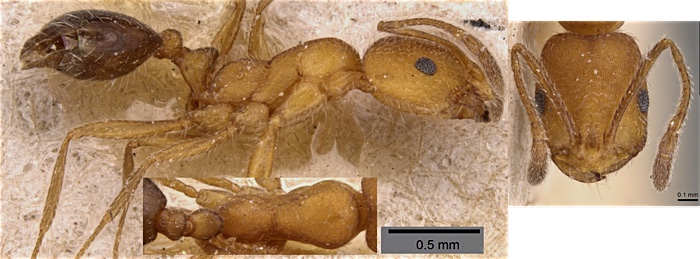 TL
2.5-2.8 mm CI 78; head rather shorter and scapes not or barely reaching
occiput; head with more numerous psammophore type hairs on underside;
also head and alitrunk shiny; gaster also shiny with a bluish sheen TL
2.5-2.8 mm CI 78; head rather shorter and scapes not or barely reaching
occiput; head with more numerous psammophore type hairs on underside;
also head and alitrunk shiny; gaster also shiny with a bluish sheen |
Egypt, Cyprus & Middle East
- nitidiventre |
| -- |  TL 2.5 mm, CI 72-76; erect hairs on head restricted, a
projecting hair near each corner of occiput; petiole profile a low triangle TL 2.5 mm, CI 72-76; erect hairs on head restricted, a
projecting hair near each corner of occiput; petiole profile a low triangle |
Egypt and
Saudi Arabia - jizane |
| . | Head only slightly elongated, CI 80 plus, oval with sides rounded; occiput not or only slightly impressed and slightly widest anteriorly | . |
| 18 |  Propodeum dorsum with deep longitudinal groove or furrow;
alitrunk profile flat with shallow metanotal groove; petiole node with
a high, round-topped profile Propodeum dorsum with deep longitudinal groove or furrow;
alitrunk profile flat with shallow metanotal groove; petiole node with
a high, round-topped profile |
19 |
| -- | Propodeum with no or only very slight longitudinal grooving; head, alitrunk and pedicel clear red or red-brown; distinctive shiny clypeus | 20 |
| 19 |  TL 3.0-3.5 mm; postpetiole ovoid in dorsal view, wider
than long; body finely shagreened, matt or slightly shiny, gaster
smooth and shiny; head alitrunk and petiole dark brown black,
occasionally reddish, gaster dark red-black, appendages brown,
mandibles yellow-brown contrasting with rest of head TL 3.0-3.5 mm; postpetiole ovoid in dorsal view, wider
than long; body finely shagreened, matt or slightly shiny, gaster
smooth and shiny; head alitrunk and petiole dark brown black,
occasionally reddish, gaster dark red-black, appendages brown,
mandibles yellow-brown contrasting with rest of head |
Israel and
Egypt abeillei |
| -- | 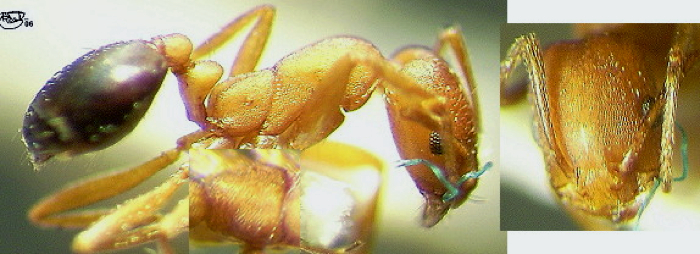 TL ca 3.0 mm?; base of gaster matt; sculpturation on front
of head relatively coarse and aligned so as to appear striate; head
& alitrunk dull yellow-red, gaster dark; alitrunk profile similar
to subopacum (below) TL ca 3.0 mm?; base of gaster matt; sculpturation on front
of head relatively coarse and aligned so as to appear striate; head
& alitrunk dull yellow-red, gaster dark; alitrunk profile similar
to subopacum (below) |
North Africa & Middle East phoenicium |
| 20 | 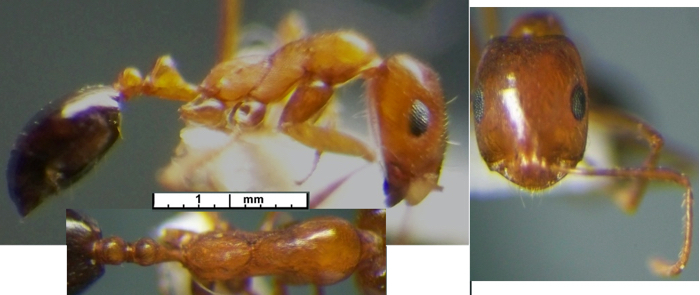 Clypeus shiny with deep
median longitudinal groove
bordered by carinae which terminate in a small tooth; TL 3.0-4.0 mm;
with deep metanotal groove; head finely granulose, near shining,
alitrunk and pedicel finely shagreened, gaster smooth and shiny;
overall clear ferruginous, gaster brown black Clypeus shiny with deep
median longitudinal groove
bordered by carinae which terminate in a small tooth; TL 3.0-4.0 mm;
with deep metanotal groove; head finely granulose, near shining,
alitrunk and pedicel finely shagreened, gaster smooth and shiny;
overall clear ferruginous, gaster brown black |
* Syria &
Ethiopia (?) venustum |
| -- | Clypeus with no more than shallow longitudinal groove; generally smaller; head, alitrunk and pedicel more or less dull; red-brown or darker | 21 |
| 21 | 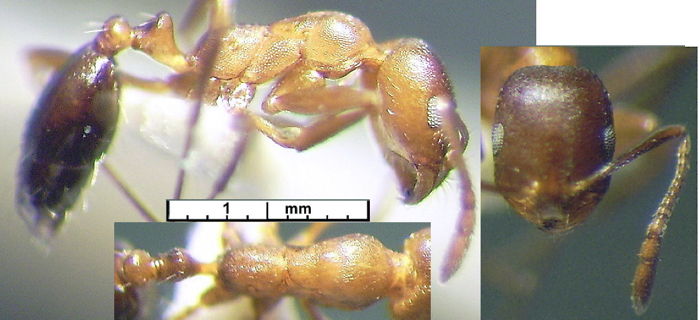 TL
2.5-3.0 mm; alitrunk with weak metanotal groove; post-petiole near
circular in dorsal view; whole of head and alitrunk matt, gaster dull
to shiny matt; colour as salomonis but usually redder; longish
hairs on underside of head; first tergite of gaster with a single pair
of erect hairs forward of row on posterior border; distinct anterior
lateral angles on gaster TL
2.5-3.0 mm; alitrunk with weak metanotal groove; post-petiole near
circular in dorsal view; whole of head and alitrunk matt, gaster dull
to shiny matt; colour as salomonis but usually redder; longish
hairs on underside of head; first tergite of gaster with a single pair
of erect hairs forward of row on posterior border; distinct anterior
lateral angles on gaster |
Circum-Mediterranean
and into Syria and Saudi Arabia subopacum |
| -- |  TL
2.5-3.5 mm; alitrunk with deep metanotal groove TL
2.5-3.5 mm; alitrunk with deep metanotal groove |
22 |
| 22 |  TL 2.5-3.5 mm; alitrunk with moderately deep metanotal
groove; propodeum with narrow longitudinal groove and margination; in
profile petiole with apex sharp; postpetiole near circular in dorsal
view and no wider than petiole; head slightly shiny, gaster quite
shiny; variably dark chestnut brown, with head and gaster often darker TL 2.5-3.5 mm; alitrunk with moderately deep metanotal
groove; propodeum with narrow longitudinal groove and margination; in
profile petiole with apex sharp; postpetiole near circular in dorsal
view and no wider than petiole; head slightly shiny, gaster quite
shiny; variably dark chestnut brown, with head and gaster often darker |
North Africa
and east to the Indian subcontinent salomonis |
| -- | Propodeum without a longitudinal groove or margination; cephalic sculpture overlain by very fine dense scratch-like longitudinal striation, large eyes, metanotal groove pronounced; higher petiole node with a relatively narrow profile | 23 |
| 23 |  TL
ca 3 mm; HL > HW; alitrunk and gaster slender; head with fine
indistinct sculpturation; eye more elongated; propodeum profile more
rounded; overall very dark brown to black, with reddish areas,
specially the mandibles TL
ca 3 mm; HL > HW; alitrunk and gaster slender; head with fine
indistinct sculpturation; eye more elongated; propodeum profile more
rounded; overall very dark brown to black, with reddish areas,
specially the mandibles |
Sahel lepineyi |
| -- | HL = HW; generally red-brown not very dark and shiny | 24 |
| 24 |  TL
3.7 mm plus; head with fairly coarse but somewhat indistinct
sculpturation; eye more nearly circular (wider in vertical plane) than
others; propodeum profile angular in effect giving three faces;
alitrunk more red-brown TL
3.7 mm plus; head with fairly coarse but somewhat indistinct
sculpturation; eye more nearly circular (wider in vertical plane) than
others; propodeum profile angular in effect giving three faces;
alitrunk more red-brown |
North Africa
& Sahel pullulum |
| -- |  TL
3.1-4.3 mm; cephalic sculpture finer; first gastral tergite with no
more than a single pair of erect hairs forward of apical row; generally
dark brown but with variable lighter areas TL
3.1-4.3 mm; cephalic sculpture finer; first gastral tergite with no
more than a single pair of erect hairs forward of apical row; generally
dark brown but with variable lighter areas |
North African Sahel zone areniphilum |
|
©2005, 2006, 2008, 2009, 2010, 2015, 2016, 2019 -
Brian
Taylor CBiol FRSB FRES 11, Grazingfield, Wilford, Nottingham, NG11 7FN, U.K. |
href="monomorium.htm"